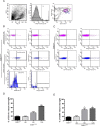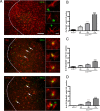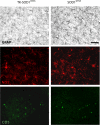Ablation of proliferating microglia does not affect motor neuron degeneration in amyotrophic lateral sclerosis caused by mutant superoxide dismutase
- PMID: 18842883
- PMCID: PMC6671032
- DOI: 10.1523/JNEUROSCI.3494-08.2008
Ablation of proliferating microglia does not affect motor neuron degeneration in amyotrophic lateral sclerosis caused by mutant superoxide dismutase
Abstract
Microglial activation is a hallmark of all neurodegenerative diseases including amyotrophic lateral sclerosis (ALS). Here, a detailed characterization of the microglial cell population within the spinal cord of a mouse model of familial ALS was performed. Using flow cytometry, we detected three distinct microglial populations within the spinal cord of mice overexpressing mutant superoxide dismutase (SOD1): mature microglial cells (CD11b(+), CD45(low)), myeloid precursor cells (CD11b(+), CD45(int)), and macrophages (CD11b(+), CD45(high)). Characterization of cell proliferation within the CNS of SOD1(G93A) mice revealed that the expansion in microglial cell population is mainly attributable to the proliferation of myeloid precursor cells. To assess the contribution of proliferating microglia in motor neuron degeneration, we generated CD11b-TK(mut-30); SOD1(G93A) doubly transgenic mice that allow the elimination of proliferating microglia on administration of ganciclovir. Surprisingly, a 50% reduction in reactive microglia specifically in the lumbar spinal cord of CD11b-TK(mut-30); SOD1(G93A) doubly transgenic mice had no effect on motor neuron degeneration. This suggests that proliferating microglia-expressing mutant SOD1 are not central contributors of the neurodegenerative process in ALS caused by mutant SOD1.
Figures





Similar articles
-
Immune reactivity in a mouse model of familial ALS correlates with disease progression.Neurology. 2001 Oct 9;57(7):1282-9. doi: 10.1212/wnl.57.7.1282. Neurology. 2001. PMID: 11591849
-
Effect of thymic stimulation of CD4+ T cell expansion on disease onset and progression in mutant SOD1 mice.J Neuroinflammation. 2015 Feb 27;12:40. doi: 10.1186/s12974-015-0254-3. J Neuroinflammation. 2015. PMID: 25889790 Free PMC article.
-
Microglia and motor neurons during disease progression in the SOD1G93A mouse model of amyotrophic lateral sclerosis: changes in arginase1 and inducible nitric oxide synthase.J Neuroinflammation. 2014 Mar 23;11:55. doi: 10.1186/1742-2094-11-55. J Neuroinflammation. 2014. PMID: 24655927 Free PMC article.
-
Significance of aberrant glial cell phenotypes in pathophysiology of amyotrophic lateral sclerosis.Neurosci Lett. 2017 Jan 1;636:27-31. doi: 10.1016/j.neulet.2016.07.052. Epub 2016 Jul 26. Neurosci Lett. 2017. PMID: 27473942 Review.
-
Transgenic mice with human mutant genes causing Parkinson's disease and amyotrophic lateral sclerosis provide common insight into mechanisms of motor neuron selective vulnerability to degeneration.Rev Neurosci. 2007;18(2):115-36. doi: 10.1515/revneuro.2007.18.2.115. Rev Neurosci. 2007. PMID: 17593875 Review.
Cited by
-
The brain's best friend: microglial neurotoxicity revisited.Front Cell Neurosci. 2013 May 16;7:71. doi: 10.3389/fncel.2013.00071. eCollection 2013. Front Cell Neurosci. 2013. PMID: 23734099 Free PMC article.
-
Microglia and Monocyte-Derived Macrophages in Stroke.Neurotherapeutics. 2016 Oct;13(4):702-718. doi: 10.1007/s13311-016-0463-1. Neurotherapeutics. 2016. PMID: 27485238 Free PMC article. Review.
-
Development of MAP4 Kinase Inhibitors as Motor Neuron-Protecting Agents.Cell Chem Biol. 2019 Dec 19;26(12):1703-1715.e37. doi: 10.1016/j.chembiol.2019.10.005. Epub 2019 Oct 31. Cell Chem Biol. 2019. PMID: 31676236 Free PMC article.
-
Links between electrophysiological and molecular pathology of amyotrophic lateral sclerosis.Integr Comp Biol. 2011 Dec;51(6):913-25. doi: 10.1093/icb/icr116. Epub 2011 Oct 11. Integr Comp Biol. 2011. PMID: 21989221 Free PMC article. Review.
-
An updated assessment of microglia depletion: current concepts and future directions.Mol Brain. 2017 Jun 19;10(1):25. doi: 10.1186/s13041-017-0307-x. Mol Brain. 2017. PMID: 28629387 Free PMC article. Review.
References
-
- Ajami B, Bennett JL, Krieger C, Tetzlaff W, Rossi FM. Local self-renewal can sustain CNS microglia maintenance and function throughout adult life. Nat Neurosci. 2007;10:1538–1543. - PubMed
-
- Alexianu ME, Kozovska M, Appel SH. Immune reactivity in a mouse model of familial ALS correlates with disease progression. Neurology. 2001;57:1282–1289. - PubMed
-
- Almand B, Clark JI, Nikitina E, van Beynen J, English NR, Knight SC, Carbone DP, Gabrilovich DI. Increased production of immature myeloid cells in cancer patients: a mechanism of immunosuppression in cancer. J Immunol. 2001;166:678–689. - PubMed
-
- Austyn JM, Gordon S. F4/80, a monoclonal antibody directed specifically against the mouse macrophage. Eur J Immunol. 1981;11:805–815. - PubMed
-
- Banchereau J, Steinman RM. Dendritic cells and the control of immunity. Nature. 1998;392:245–252. - PubMed
Publication types
MeSH terms
Substances
LinkOut - more resources
Full Text Sources
Other Literature Sources
Medical
Molecular Biology Databases
Research Materials
Miscellaneous
